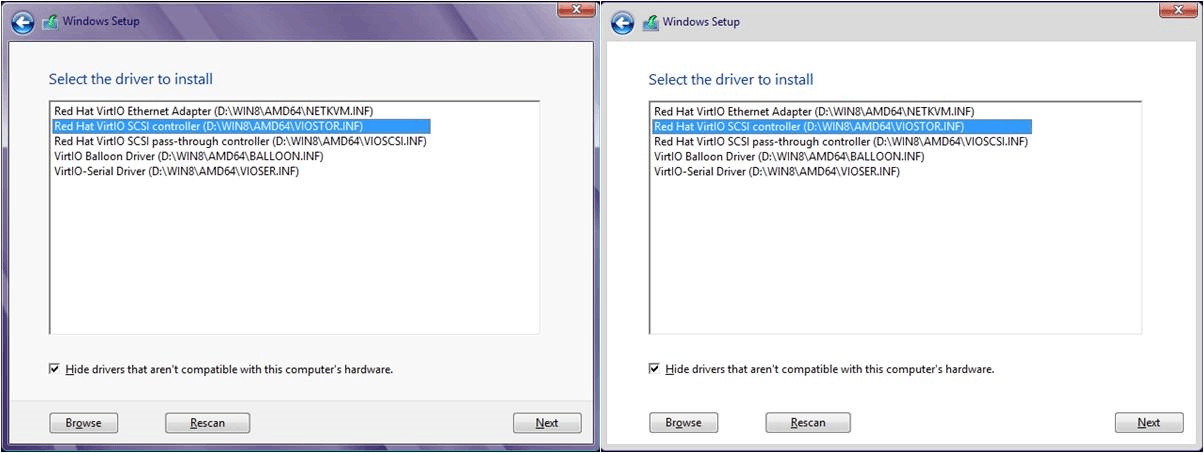- Ovirt Driver Download
- Ovirt Driver Download Windows 7
- Ovirt Driver Download Pc
- Ovirt Driver Download Windows 10
When installing a Windows server on oVirt, Inter-Network Interfaces ”,“e1000”and” Disks come as “IDE”. Otherwise, your server will not turn on. This also affects the performance of the machine. Therefore, you should do ”Network Interfaces”, “VirtIO” and “Disks”, “VirtIO-SCSI… Thus, your machine will operate at a smooth performance.
Ovirt Driver Download
In order to do this configuration, you must install oVirt Guest Agent Driver (oVirt-toolsSetup) after installing the Windows server. You must first download the corresponding version of oVirt-tools-setup.iso (https://resources.ovirt.org/pub/ovirt-4.2/iso/oVirt-toolsSetup/), mount it as a CD Drive, and then perform the typical * .exe installation… After the installation is finished,
The oVirt Guest Tool ISO provides a collection of tools usable for Windows VMs that run under KVM (oVirt). It also includes an installer to make the tools installation as easy as possible. The oVirt Guest Tools Installer installs all VirtIO-Win device drivers (Balloon, Serial, Net, Block and SCSI) along with Spice Agent and QXL drivers.
Pull the network setting from e1000 to VirtIO.
- I'm a nube with ovirt, but have the ovirt-engine and 1 remote host up and running (separate physical servers, same subnet). The network, DNS. I can create VM's, install the ISO OS with no problems. Here is were I get stuck. After a frustrating few hours trying to get a console to launch on my mac.
- Binary drivers are provided by some Linux distributions including WHQL Certified drivers. For example the binary drivers for Ubuntu can be found here. 64-bit versions of Windows Vista and newer (this currently includes Windows Server 2008, Windows 7, Windows 8, Windows Server 2008 R2 and Windows Server 2012) require the drivers to be digitally.
Set the disk settings to VirtIO-SCSI from the IDE.
I hope it has been a useful article.
Device drivers improve sound, graphics, networking, and storage performance. If you perform a custom VMware Tools installation or reinstallation, you can choose which drivers to install.
The set of drivers that are installed when you install VMware Tools depends on the guest operating system and the VMware product. For detailed information about the features or functionality that these drivers enable, including configuration requirements, best practices, and performance, see the documentation for your VMware product. The following device drivers can be included with VMware Tools.
On Windows guest operating systems whose operating system is Windows Vista or later, the VMware SVGA 3D (Microsoft - WDDM) driver is installed. This driver provides the same base functionality as the SVGA driver, and it adds Windows Aero support.
For example, Windows Server 2008 defaults to LSI Logic SAS, which provides the best performance for that operating system. In this case, the LSI Logic SAS driver provided by the operating system is used.
VMware supplies a special SCSI driver for virtual machines that are configured to use the BusLogic virtual SCSI adapter. Virtual machines do not need this driver if they do not need to access any SCSI devices or if they are configured to use the LSI Logic virtual SCSI adapter.
Ovirt Driver Download Windows 7
The driver is included as part of the VMware Tools package or comes bundled with VMware ESX/ ESXi. It is available on the host as a floppy image at /vmimages/floppies/vmscsi.flp. The driver can be used in Windows XP, Windows Server 2003, or Windows 2000.
When you install VMware Tools, a VMXNET NIC driver replaces the default vlance driver.


- File Introspection Driver: The File Introspection driver uses the hypervisor to perform antivirus scans without a bulky agent. This strategy avoids resource bottlenecks and optimizes memory use.
- Network Introspection Driver: The Network Introspection driver supports NSX for vSphere Activity Monitoring.
Ovirt Driver Download Pc

Ovirt Driver Download Windows 10
Do not delete or replace existing inbox drivers for Linux that are distributed by your OS vendors. Deleting or replacing these drivers might cause conflict with future updates to the drivers. Contact your OS vendor or OS community for availability of specific updates to drivers.
See http://kb.vmware.com/kb/2073804 for information about availability, maintenance, and support policy for inbox drivers for Linux.
If you use Workstation or Fusion, you can install the Shared Folders component. With Shared Folders, you can easily share files among virtual machines and the host computer. The VMHGFS driver is a file system redirector that allows file system redirection from the guest operating system to the host file system. This driver is the client component of the Shared Folders feature and provides an easy to use alternative to NFS and CIFS file sharing that does not rely on the network. For Linux distributions with kernel version 3.10 and later, a new FUSE based Shared Folders client is used as a replacement for the kernel mode client.
VMware Tools installation include the VMware AppDefense, a security management and monitoring solution. AppDefense agent can be installed on the guest virtual machine using the VMware Tools installer. However, VMware Tools cannot install the AppDefense component automatically. You need to install the component manually.

